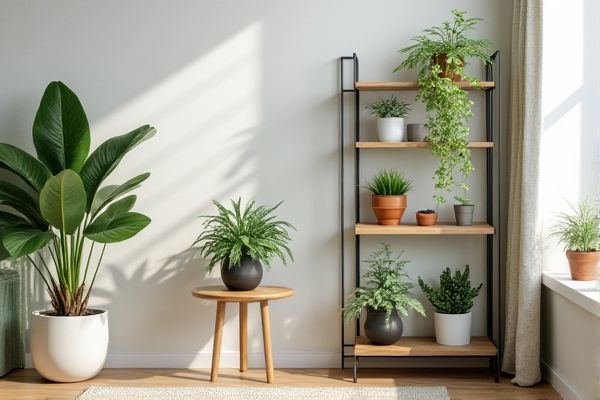
A plant stand is typically a single-tiered structure designed to elevate plants off the ground, while a plant shelf often features multiple levels for displaying several plants at once, maximizing vertical space. Discover how choosing the right option can enhance Your indoor garden by reading the full article.
Table of Comparison
| Feature | Plant Stand | Plant Shelf |
|---|---|---|
| Purpose | Elevates individual plants for display | Holds multiple plants on horizontal surfaces |
| Design | Compact, often single or tiered stands | Multi-level shelving units |
| Material | Wood, metal, or plastic | Wood, metal, plastic, or composite |
| Space Utilization | Effective for small or limited spaces | Optimizes vertical space with multiple tiers |
| Mobility | Lightweight and easy to move | Usually heavier and less portable |
| Typical Use | Showcasing individual plants or pots | Organizing several plants together |
Introduction: Plant Stand vs Plant Shelf
Plant stands offer elevated support for your plants, enhancing air circulation and providing a dynamic display mode ideal for smaller spaces or accentuating a single plant. Plant shelves, designed with multiple tiers, maximize vertical storage and accommodate several plants, making them perfect for creating indoor green walls or organized botanical collections. Choosing between a plant stand and plant shelf depends on your space, aesthetic preference, and the number of plants you want to showcase.
Defining Plant Stands and Plant Shelves
Plant stands are freestanding structures designed to elevate individual or grouped potted plants, often featuring multiple tiers for vertical display. Plant shelves are attached to walls or integrated into furniture, providing horizontal surfaces for arranging plants while optimizing space. Both options enhance plant visibility and accessibility, but plant stands offer mobility whereas shelves provide a fixed display solution.
Key Differences Between Plant Stands and Shelves
Plant stands typically feature a single tier or a few levels designed to showcase individual plants, offering portability and height customization for optimal sunlight exposure. In contrast, plant shelves provide multiple horizontal surfaces fixed to a wall or freestanding, maximizing vertical space and allowing for the display of numerous plants simultaneously. Understanding these key differences helps you choose the best option to fit your space, plant collection, and aesthetic preferences.
Space Optimization: Which Is Better?
Plant stands maximize vertical space by elevating individual plants, ideal for small areas needing height utilization, while plant shelves offer broader surface area for multiple plants, accommodating diverse pot sizes and arrangements. In tight rooms or balconies, compact plant stands optimize floor space without clutter, whereas plant shelves provide layered storage, reducing the need for extra furniture. Choosing between a plant stand and plant shelf depends on available space dimensions and the number of plants, with stands favoring vertical optimization and shelves enhancing horizontal capacity.
Aesthetic Appeal and Design Options
Plant stands offer a versatile range of aesthetic appeal with their sculptural, often elevated designs that highlight individual plants and add dimension to any space. Plant shelves provide a streamlined, functional display with multiple tiers, ideal for showcasing a variety of plants in a cohesive, organized arrangement. Both options come in diverse materials like wood, metal, and rattan, catering to modern, rustic, and minimalist interior styles.
Functional Benefits of Each Solution
Plant stands offer superior mobility and customizable height options, making them ideal for showcasing individual plants in various locations and maximizing sunlight exposure. Plant shelves provide extensive surface area for multiple plants, enabling efficient space utilization and creating layered indoor gardens that enhance room aesthetics. Both solutions contribute to healthier plants by improving air circulation and organization, but stands excel in flexibility while shelves prioritize capacity.
Best Plants for Stands vs. Shelves
Plants with trailing vines, such as pothos and philodendrons, thrive on plant shelves where they can cascade freely and create visual interest. Stands are ideal for larger, potted plants like fiddle leaf figs or snake plants that require stability and elevation to receive ample sunlight. Succulents and small ferns fit perfectly on plant shelves, while tall or heavy plants benefit from the sturdy support of plant stands.
Material Choices and Durability
Plant stands often feature metal or wood construction, offering sturdy support and resistance to outdoor conditions, while plant shelves are typically made from wood, MDF, or plastic, balancing durability with aesthetic appeal. Metal plant stands provide excellent durability against rust and weather, making them ideal for both indoor and outdoor use, whereas wooden plant shelves may require more maintenance but add natural warmth to your space. Your choice between a plant stand and shelf should consider the material's resistance to moisture, weight capacity, and overall durability to ensure long-lasting plant display solutions.
Maintenance and Cleaning Considerations
Plant stands require regular dusting and occasional tightening of screws to maintain stability, especially if made of metal or wood prone to rust or warping. Plant shelves, often wall-mounted, demand thorough cleaning of both the shelf surface and the wall area to prevent moisture damage and mold growth from watering spills. Your choice should consider ease of cleaning access and durability of materials to ensure long-term maintenance efficiency.
Choosing the Right Option for Your Home
Selecting between a plant stand and a plant shelf depends on the available space and aesthetic preferences in your home. Plant stands offer mobility and height variation for showcasing individual plants, while plant shelves provide more surface area, ideal for grouping multiple greenery displays. Consider room dimensions, natural light exposure, and the types of plants to create a balanced, visually appealing indoor garden setup.
 homyna.com
homyna.com